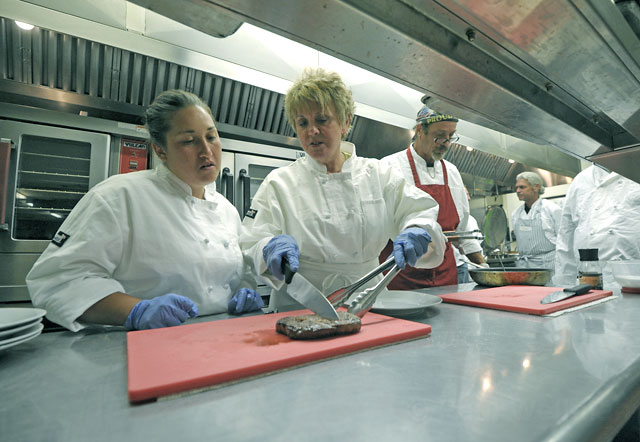Someone’s in the Kitchen at Esperanza
The Homeless Shelter’s Culinary Arts Training Program

The class, a wide-raging group from their twenties to their fifties, listens attentively as Chef Anita Krissel lectures, highlighting their notes about dry-heat cooking methods for chicken. As they are about to break from the lecture portion of the evening and move to the hands-on cooking, Krissel drills them: “What do you do first in the kitchen?”
The class responds: “Wash our hands.”
“And second?” she asks.
“Set up our mise-en-place,” they reply, using the French term for kitchen prep like it’s an everyday term.
Krissel pauses and then says, “And what do you do before anything else?” There’s a tiny moment, and one student suggests, “Have a cigarette?”
The students that crack up at the not-quite joke seem like any other cooking class, until you realize they are all temporary residents of Casa Esperanza on Cacique Street. This class is the Culinary Arts Training Program, already in its second three-month session of twice-a-week classes, providing the homeless with skills to help them change their lives. “We can’t just be seen as the organization who warehouses people and keeps them homeless,” explained Rob Grayson, Casa Esperanza’s director of development. “Our goal is to create programs and give them skills. It’s solution-oriented.”
But Grayson realizes that a solution isn’t necessarily easy. “People end up in a homeless shelter for a reason, and that makes this tricky on Anita,” he admitted. “But the students get much more than cooking skills. They learn how to show up on time, how to be responsible.”
One such shining example is Jacob, a graduate from the first class who has landed a job as a line cook at the new Snack Shack. “This is something positive for everyone,” said Jacob, who helps the second class as a sort of teaching assistant when not working. “These are people in the worse situation they could be, and it teaches them a trade or ignites a passion they had long forgotten. It’s about empowerment, either connecting the dots that already existed or teaching them something new.”
When the classes of 10 graduate and pass their ServSafe test (the first group all did so easily), they get a set of chef’s knives and help finding an externship. “We put someone into a kitchen for two weeks for free,” Grayson explained. “If it works out and you have a place for the person and want to hire them, great. If you can’t, we hope you can at least recommend them.”
It helps that the program has a benefactor in Chef Michael Blackwell from the Montecito Country Club, who uses his contacts to set up externships and preps the students for interviews. “I’m calling all chefs to come and help these people,” said Blackwell. “It’s about our community. Help them be a part of us. Help us help them.”
4•1•1
Sponsor a student, make a smaller donation, or volunteer your time to help keep the Culinary Arts Training Program at Casa Esperanza going strong: thecatprogram.org.



